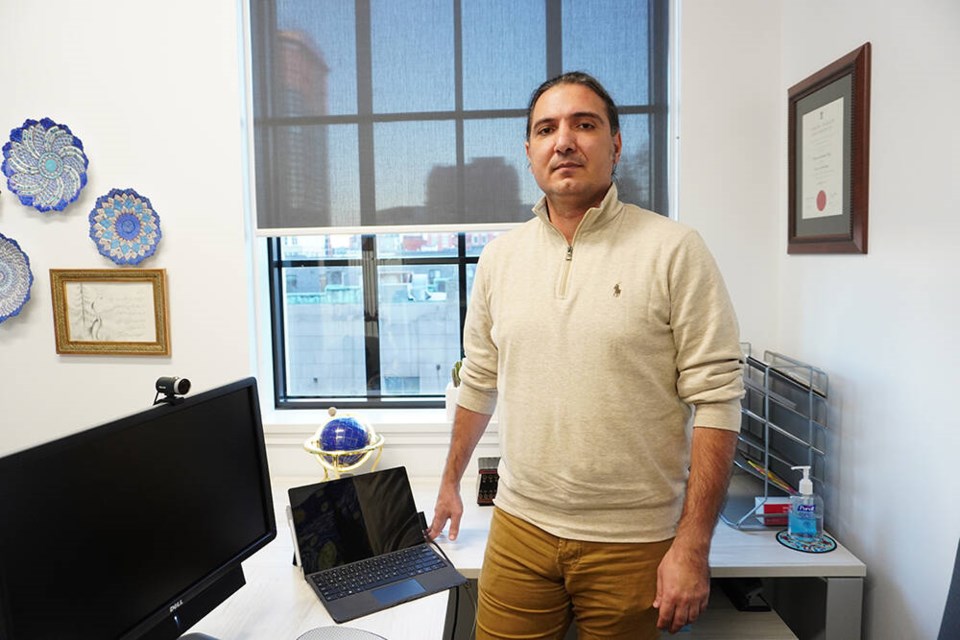Ashkan Jafarian arrived in Vancouver, B.C., just two months ago and currently resides on the North Shore.
Initially, he was a visitor, but he now holds an open work permit due to the extension of the Government of Canada’s temporary immigration, passport and citizenship measures for Iranians in Canada.
“I am seeking a secure job that will enable me to bring my family here,” he said. His wife and their nine-year-old daughter reside in Iran, more than 10,000 kilometres away from him.
In 2023, Canada responded to the uprising in Iran and the Women, Life, Freedom movement by considering a condition for Iranian temporary residence.
“In light of the gross and systematic human rights violations being committed by the Iranian regime during its brutal crackdown on protesters, some may wish to prolong their stay in Canada rather than return home at this time,” the government stated, and the program has since been extended until Feb. 28, 2025.
The movement in Iran began following the death in custody of 22-year-old Mahsa Amini, who was arrested in Tehran by morality police on Sept. 16, 2022. Since the protests started in Iran, there have been at least 537 deaths and 22,000 arrests.
A UN fact-finding mission on the Islamic Republic of Iran made its first report on March 8, stating that “Institutional discrimination against women and girls enabled human rights violations and crimes against humanity in the context of recent protests.”
Given the situation in Iran, Jafarian says that the journey to Canada offers people like him, who have children, a significant opportunity to give their children a chance to grow in a free society where their decisions are valued.
“Many Iranians wish they had the opportunity,” he said. “I hope to bring my family here to provide a brighter future.”
Mohsen Javdani, an associate professor of economics at Simon Fraser University’s School of Public Policy, believes that the experience of non-permanent residents and people on work permits suggests that Iranians arriving in Canada under this policy are likely to face considerable challenges and are at a high risk of exploitation and mistreatment by employers.
“This is due to their uncertain immigration status and lack of a clear path to permanent residency and stability in Canada,” said Javdani. “The lack of alignment between the eligibility criteria of these policies and the humanitarian framing with mounting evidence regarding challenges faced by newcomers to Canada highlights significant gaps and false hopes in the experience of many Iranian newcomers taking advantage of this temporary public policy.”
Javdani pointed out that, given its short duration, no government statistics or systematic studies are available to help understand the experiences of Iranians who have entered Canada under this temporary public policy.
“It is important to put into place appropriate programs, frameworks, and infrastructures that would help mitigate some of the challenges and struggles of these Iranian newcomers to Canada,” he added.
Most of Javadani’s research focuses on the inequalities experienced by marginalized groups in the labour market. He questions whether the program has the necessary support mechanisms and services to facilitate integration into the labour market and society.
“Canada’s commitment to immigration and humanitarian support is laudable, but there must also be a genuine commitment to building inclusive and supportive frameworks and programs to mitigate the increasing challenges faced by newcomers to Canada,” he said. “The absence of such frameworks to mitigate challenges like precarious working conditions and challenging living conditions inevitably leads to these policies primarily benefiting business and property owners, leaving other members of the society, especially newcomers to Canada, behind.”
According to the IRCC report, Iran is one of Canada’s top 10 source countries for permanent residents in 2022.
Challenges, community, and policy concerns
Jafarian used to work as a sales marketing expert in Iran. Before he travelled to North Vancouver, he secured temporary accommodation through one of the Iranian Telegram channels whose members reside in Vancouver.
“The community can facilitate this matter for immigrants like me,” he said. About 80,000 to 90,000 people identify as Iranian in the larger Lower Mainland area.
Javdani believes that immigrants usually gravitate towards larger cities.
“The main driver of this is motivation, the willingness to move to communities where there are already more opportunities, especially upon arrival, for networking and seeking help and support,” he said. “Therefore, the North Shore in Vancouver, B.C., historically is one of those communities. Given the existing large Iranian community on the North Shore, it could provide an easier transition into Canadian society.”
However, Javdani emphasized that a significant portion of these workers are engaged in occupations that are deemed essential, yet characterized by low wages, long hours and precarious employment conditions with no clear path to stability and permanent residency.
“Many of them fall outside the National Occupational Classification (NOC) attached to various occupations that determine eligibility for permanent residency for these newcomers,” he said. “The public justification provided by the Government of Canada for this specific policy is largely humanitarian, framing it as a response to the deteriorating sociopolitical situation in Iran. However, I have some doubts about the way in which the government has framed this temporary public policy as a humanitarian program.”
He continued: “This raises important questions for me about the potential for strategic deployment of temporary public policy framed with humanitarian considerations, but aim to address labour market shortages, inflationary pressures, and other challenges in Canada while avoiding an explicit increase in official immigration figures, in light of the recent substantial increase in opposition towards immigration among the public in Canada.”
Hamid Jafari is a Vancouver-based freelance journalist who writes about the Iranian community in Canada, art, culture, and social media trends. His work for the North Shore News is supported by New Canadian Media. [email protected]



